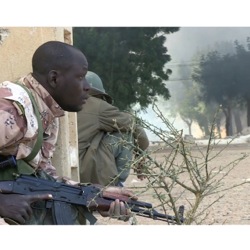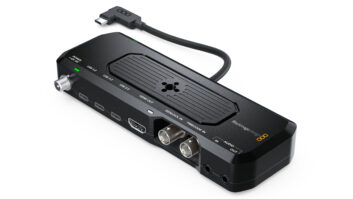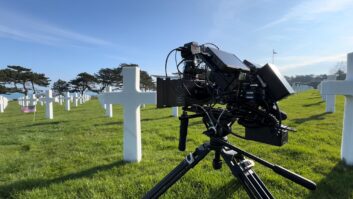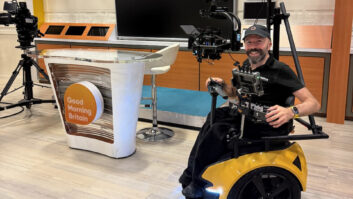
The delivery of outstanding editorial coverage often from highly dangerous locations has always been the identifier behind the Sony sponsored Rory Peck Awards, but the 2013 finalists took the journalistic values of freelancing to astonishing new heights
Boosted by a record entry of 73 titles – with 21 being British, seven American, six French, and 16 nations providing just one entry – the nine finalists across three categories focused on three Syrian stories, two stories from Bangladesh, plus single reports from Mali, Somalia, Afghanistan and Kashmir.
Setting the context and mood for the event, Rory Peck Trust chairman Michael Jeremy said: “It is good that freelancers are recognised, but they are not recognised enough. It is good that they have more access to safety and protection, but they are still not safe enough.”
“Often at great personal risk they produce remarkable work that plays a crucial role in shining a light into dark places. Those of us that believe in transparency and well-informed democracy should be grateful that committed freelancers exist.”
The Trust is a safety net, but sometimes it has to say no and cause heartbreaks on both sides. How big should it become to achieve everything that director Tina Carr thinks it must cover?
“I think we are too small to really fulfill our remit,” said Carr. “We do not want to become an enormous organisation because we would lose our very personal touch. We just want to be big enough to be able to help maybe double the number of cases we are able to support now fully. We are mainly getting to people through social media, and that has opened up the whole thing.”
Talking about the competition Carr said: “The quality was astounding. The people who were getting the stuff in just said it was the best they have seen in the 17 years of the event.”
It was kill or be killed
In the news section Aris Roussinos (pictured) triumphed with his online video, Ground Zero Mali: The Battle of Gao, the product of four weeks of self-funded effort that saw him embed with Malian troops as they battled with Mujao Islamists holding local buildings. This was a tale of poorly trained and undisciplined troops fighting much younger and better-trained jihadists. The full film was hosted by VICE.
What led Roussinos to self-fund such a dangerous assignment? “Mali was a big story at the time, but was relatively uncovered,” he said. “When I arrived all the other journalists were French, and while there were no formal reporting restrictions, they chose to self censor.”
Roussinos has vast experience of embedding with rebel groups (in Sudan, Libya and Syria), and says freelancers have developed a very specific reporting tactic.
“Particularly post the Arab Spring, your only choice is to embed with different rebel groups, primarily for monetary purposes,” he said. “They basically feed you and look after you for free as long as you expose their viewpoints to the world.”
This gambit is the theme of a book Roussinos is writing. Did the Malian military realise he made them look incompetent? At one point he had to dive to avoid friendly fire.
“That’s harsh. I did not intend to make them look stupid,” he said. “They were lovely guys, and the real issue is that it is actually obscene sending completely untrained soldiers into war.”
Roussinos used the Canon XF105, which he had seen Al-Qaeda use by preference in Syria. Was the fact that the jihadists when eventually killed proved to be children, a shock?
“It was pretty bleak. I was with the French and this kid of about 15 jumps out and pointed his AK at us. A French soldier shot him and he died right in front of us,” he said. “Obviously it was kill or be killed, but it was pretty dark realising that the people I was with were fighting children, who were better trained and were better soldiers than the troops I was with before the French stepped in.
“Those soldiers they were loving it though. Clearly they all saw themselves as heroes, and they were all videoing each other to put on Facebook. War is inherently ludicrous,” he added.
Unpleasant and complex experiences
The feature section winner was Olly Lambert (pictured) for the five weeks he put into Syria Across The Lines, during which he split his time between Sunni Muslim fighters and regime-supporting soldiers a single village away.
His comments started with some hard truths. “Award ceremonies are good fun, but they always strike me as uncomfortable because they are a world away from the process that one goes through in order to get there,” he said.
“I have done 10 films in areas of conflict that involved living for quite a long time in different places and I am very aware of a habit I have, and I think many others have, which is when you get back you convert what was quite an unpleasant and complex experience into a simple and rather adventurous narrative, and there is a dishonesty about that,” he added. “So when I was in Syria I kept a very detailed diary. I was trying to send a message to myself in the future, not to forget the reality of the experience, which is that it is not only dangerous, but it is miserable, lonely, isolating and difficult.”
Lambert questioned whether he had it himself to do justice to this enormous tragedy. “What difference could me and my little camera ever make?”
Upfront he spent months looking for the right Syrian fixer. He eventually spoke to Abdul via Skype, and then met him in Istanbul. “We spent months preparing for the shoot, and looking for the right fixer was one of the key tasks,” he said. “He taught me so much about the world I was in. He would translate not just what people were saying, but the meaning of our situation.”
At one point a sniper shot at Lambert when he was with a farmer, but he lived to pull off an interview with the guy who tried to kill him.
“I had lived with the rebel side first and it was four weeks later that I ended up on the other side of the valley,” he said. “I cannot be certain he was the exact person who shot at me, but I suggested that I interview the commander in the sniper position, and while we were there I zoomed the camera in down the road and could see the very ditch I hid in a few weeks earlier.
“There was an awkward moment when I asked him does he ever fire on farmers, and he said no. Obviously I knew that he does fire on farmers,” he added. “I could not have planned for that moment, but by being able to show both sides of that event tells the world that war is depriving a whole community of farmers of livelihood and work. They can either stay at home to protect their families or risk their lives to look after their crops.”
Life expectancy of 50
The Sony Impact Award went to Soumen Guha and Dipak Chandra Sutradhar, for Hazaribagh: Toxic Leather, an eye opener on a squalid and unhealthy tannery environment where life expectancy is 50 due to variable cancers, and on the wider environmental damage the chemicals wreak in rivers.
A French crew went after the same story, but was arrested. How did Soumen and Dipak succeed? “We are well known in our country and we said: ‘We are filming for your personal interests, and airing it will represent everybody who is involved with this industry’. Bangladesh is a third world country and just like everywhere else there are politics, but everybody has to do their best to help their industry become big and professional,” he said.
He shot for 15 days and had moved onto another job when the production house wanted something extra and Sutradhar joined him and added four days of story rushes.
“When I shot my footage the environment was so dirty I went home and vomited,” said Sutradhar.
The most telling shot in their film is when fishermen cast their nets in a river, and catch not one minnow. “The river is totally dying because of chemical pollution,” he added.
Could have engaged better
Speaking for the awards sponsor Olivier Bovis, head of marketing, Sony Professional Solutions said: “Reflecting on being a judge for the impact category for six years, I have seen an increased quality in terms of editorial content.”
The reasons could be more entries, the use of better compact HD kit, or because: “These guys are fighting their corner against the best You Tube stupid video type of stuff.”
Sony backs the Trust for ethical reasons, but Bovis admitted: “From a kit point of view what we’ve learnt is not as much as we should have. We could have engaged better with freelancers to help us design the camcorders for the next generation and the one following.
“With the arrival of DLSR video shooting a few years back, and products like GoPro the landscape of all the compact devices have changed radically,” he added. “There are new technologies to embed like wireless streaming.”
By George Jarrett






